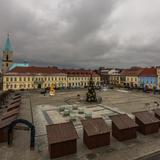It is under the castle where you can find the renovated Chewra Lomdei Misznajot Synagogue from 1914 r, which is now used as a sanctuary place, and in the neighbouring building there is Jewish Centre which handles the history documentation of Jews from Oświęcim. The synagogue is the only memorial survived after former Jewish community, which in different time periods constituted almost half of city’s inhabitants.
From the castle it is worth to have a walk towards the Market Square where you will pass the parish Church of the Assumption of the Virgin Mary. It was erected as a Gothic sanctuary, but many reconstructions eliminated the initial style features. The second one of the churches in Oświęcim situated in the territory of Old Town is St. Mary Church of the old monastery of Dominicans, and presently of Salesians. The Gothic, brick edifice looks most beautiful from the side of the Soła River as it seats on the edge of the steep slope. Next to it, towers the Gothic chapel of St. Jack from the beginning of the XIV century; primary it was a capitulary of monastery. The centre of the former city was the Market Square. Around the square, on the neighbourhood streets you can find diminutive, usually one-storey, city residences. The most interesting one is the classical manor of the Ślebarski family from the beginning of the XIX century, which presently houses the District Court.
Boulevards by the Soła River are perfect for walks. On the river’s bank you can find fragments of naturally precious Riparian Forests. The promenade along boulevards was created just under the slope, on which Old Town centre was established.
The most important purpose of tourists in Oświęcim is to visit the former Auschwitz-Birkenau Nazi German Concentration and Extermination Camp inscribed on the UNESCO List of Word Cultural and Natural Heritage. The older part of the camp, established in the year 1940 is situated on the suburbs of Oświęcim. Today, this area is the museum and memorial. The entrance leads through steel gate with the inscription Arbeit macht Frei (work makes you free). In brick barracks for prisoners the museum exhibitions devoted to victims of various nationalities from many countries were created. Next to the block no 11 there is the Death Wall in front of which the prisoners were shot. The second camp which is bigger was created in 1942 in Brzezinka, about 3 km (2 miles) away from the camp in Oświęcim. Presently it is mostly the shocking, and immense necropolis. Till the year 1945 about 1.5 millions of people were killed here, mostly Jews, but also Poles, Gypsies, Russians and prisoners of many nationalities from 28 countries. You can find here the remains of gas chambers, crematories and some of the wooden barracks. From the Death Gate to the monument of the Killed there is a side track rail and a ramp on which prisoners taken from carriages were selected; some of them were taken directly to the gas chambers, the minor rest of them were leaded to the camp.
Worth seeing in the vicinity !
The Wooden Church in Poręba Wielka.
In Polanka Wielka you can not only see a church from the half of the XVI century (also made of wood), but also the palace and park complex. Church of St. Andrew in Osieka is the most precious of the wooden churches in the Oświęcim region. The Palace in Osieka from the XVIII century was reconstructed in the middle of the XIX century in the Moorish style.
The Carp Valley is the region famous for fish ponds situated along the waters of the Vistula River between Oświęcim and Zator. Many carps caught in this pond constitute one of the best delicacies of Małopolska, if they are properly prepared. In Zator you can see a Gothic, parish church and the old castle where princes from Zator used to live, which in the XIX century was rebuilt in the neo-Gothic style. Under the city there is a fun fair Dinozatorland presenting the exhibition of dinosaur’s skeletons, and a park with movable models of these prehistoric creatures.
The Heritage Park in Wygiełzów, where many examples of regional wooden architecture were collected, including a XVI century church from Ryczów and the impressive manor from Droginia. In the neighbourhood there are ruins of Lipowiec Castle which are available for tourists.

